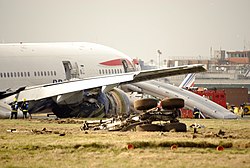British Airways Flight 38 investigation focuses on fuel system
Saturday, January 26, 2008

Image: Marc-Antony Payne.
Investigators examining the wreck of British Airways Flight 38, a Boeing 777 that crash landed short of the runway at London's Heathrow Airport in the first hull loss of a 777, are examining the aircraft's fuel system as a possible factor in the crash. No-one was killed as the scheduled flight from Beijing, China lost power during final approach on January 17.
136 passengers and 16 crew were on board when power was lost to the two Rolls-Royce engines about two miles from the runway, at a height of 600 feet. Autopilot and autothrottle were engaged at the time, the latter having just commanded an increase of thrust to the engines when power was lost. Co-pilot John Coward, in control at the time, was subsequently praised for being able to glide the disabled plane to within 1,000 feet of the runway, clearing a number of houses along the way.
Subsequent investigation has revealed that not only did the engines not fail simultaneously, but neither failed completely, contradicting initial belief. A preliminary report by the United Kingdom's Aircraft Accident Investigation Branch (AAIB) stated that after the autothrottle commanded more thrust "The engines both initially responded but after about 3 seconds the thrust of the right engine reduced. Some eight seconds later the thrust reduced on the left engine to a similar level... Both engines continued to produce thrust at an engine speed above flight idle, but less than the commanded thrust." This situation prevailed until impact.

Image: Markie/Open Street Map .
On Wednesday the AAIB stated that they were examining "All possible scenarios that could explain the thrust reduction and continued lack of response of the engines." However, it also went on to specifically mention attention to the jet's fuel system, saying "This work includes a detailed analysis and examination of the complete fuel-flow path from the aircraft tanks to the engine-fuel nozzles." The AAIB also ruled out the plane having completely run out of fuel, stating that there was "adequate fuel" in the tanks when the plane crashed. In addition to the fuel required to get to the target destination or emergency alternative airport - whichever is further - aircraft typically carry between thirty and forty-five minutes worth of extra fuel as a safety margin.
Possible scenarios being examined include fuel contamination, coming either from fuel taken on at Beijing or leakage from an unknown source. In particular, a heavy contaminant at the bottom of the tanks would explain a lack of earlier problems on the flight, as the fuel levels would only have become low in the final stages of the trip. Another possibility is that a central part of the fuel system developed a leak, reducing the amount of fuel available to the engines.
It is known that, according to the AAIB, "the autothrottle and engine-control commands were performing as expected prior to, and after, the reduction in thrust," suggesting that all software in the aircraft was functioning correctly and rendering a software failure unlikely, although this possibility also remains under investigation.
Related stories
- "Co-pilot steered stricken Heathrow jet to safety" — Wikinews, January 20, 2008
- "British Airways flight lands short of runway at London Heathrow Airport" — Wikinews, January 17, 2008
Sources
- Dominic Gates. "Investigators in 777 crash looking at fuel systems" — Seattle Times, January 25, 2008
- Kevin Done. "Crash jet ‘had enough fuel’" — Financial Times, January 24, 2008
- "BA crash-landing inquiry to focus on jet's fuel pipes" — The Scotsman, January 24, 2008

